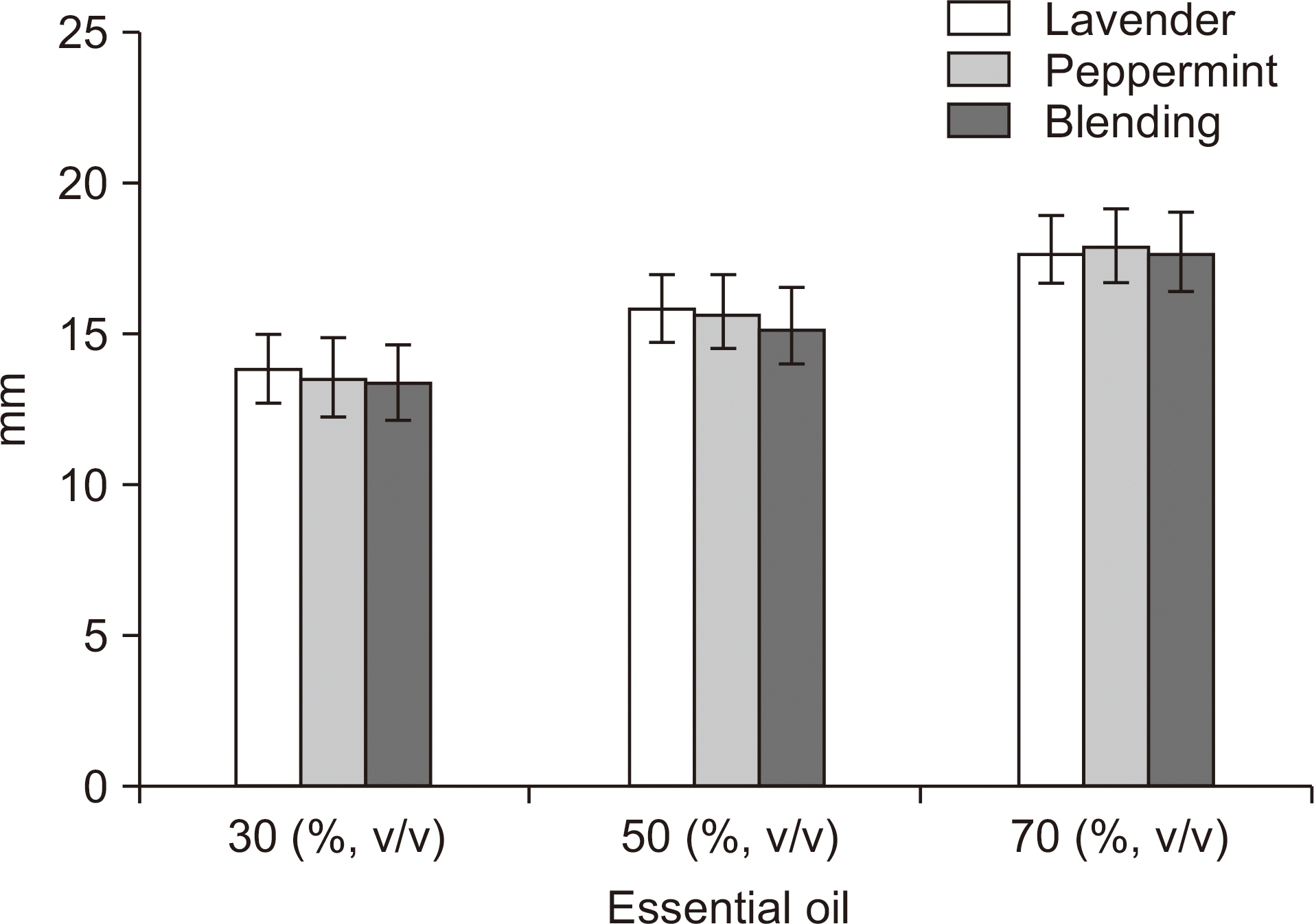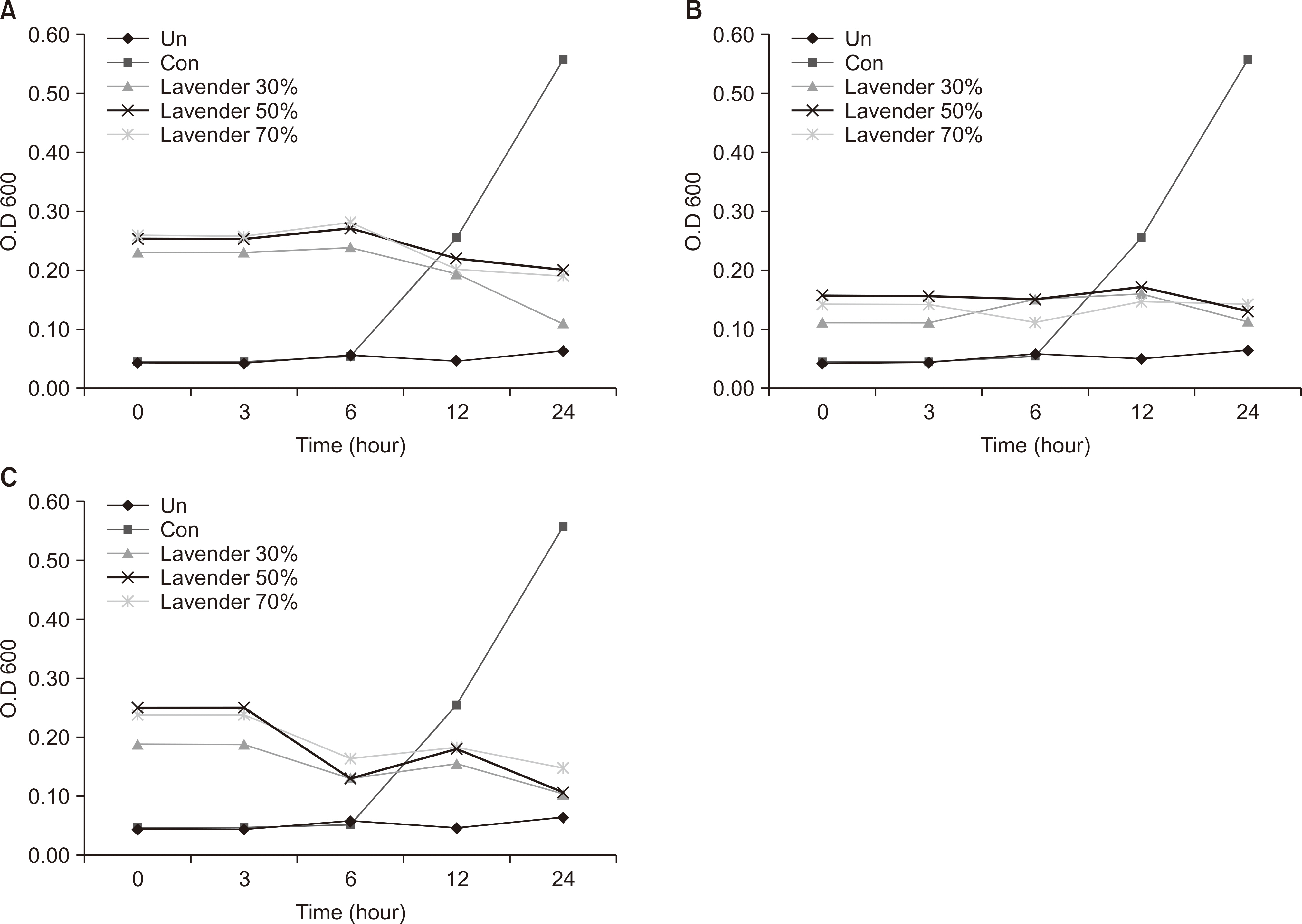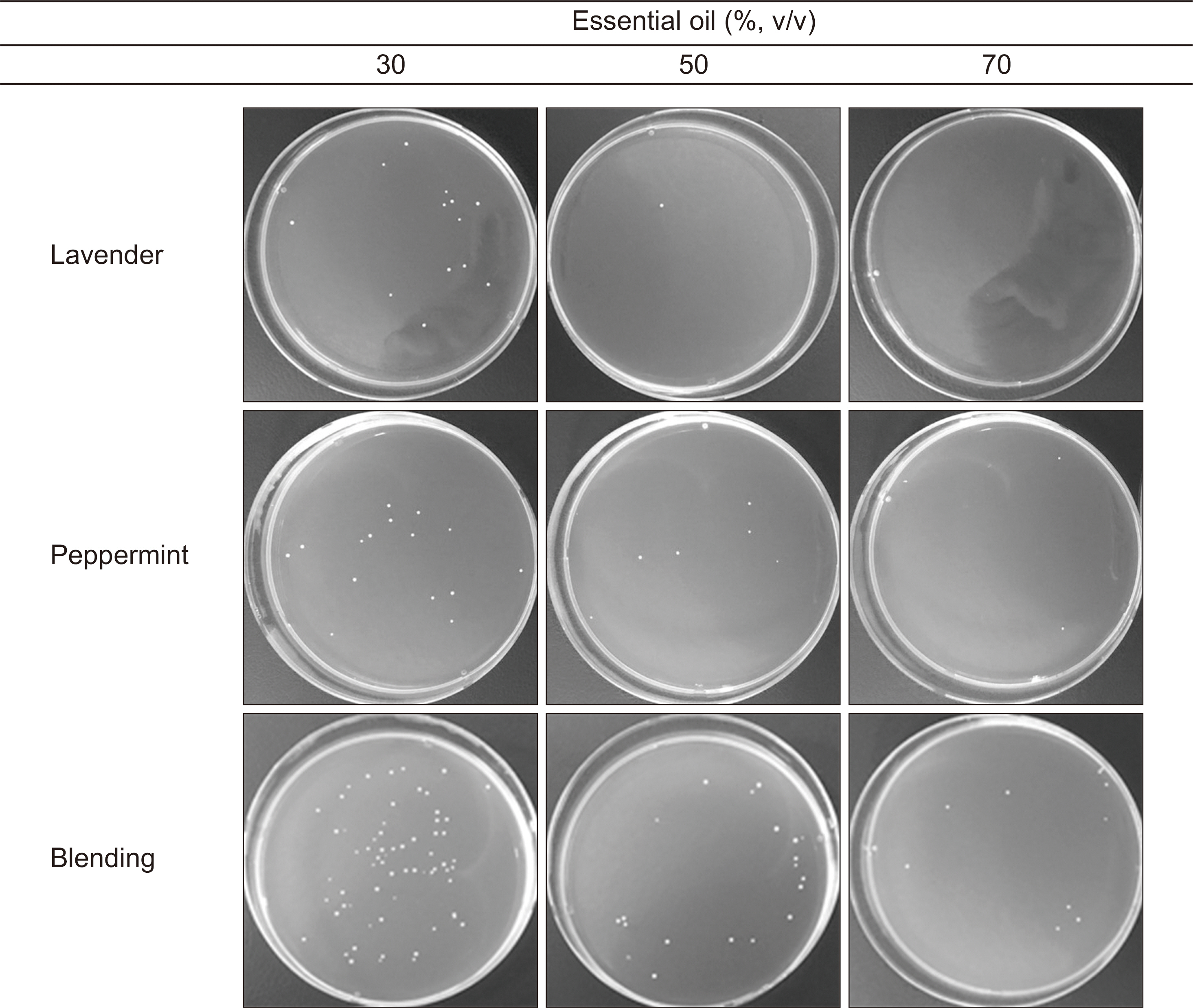J Korean Acad Oral Health.
2018 Dec;42(4):210-215. 10.11149/jkaoh.2018.42.4.210.
Anti-bacterial effects of lavender and peppermint oils on Streptococcus mutans
- Affiliations
-
- 1Department of Clinical Laboratory Science, Dong-Eui University, Busan, Korea.
- 2Department of Dental Hygiene, Dong-Eui University, Busan, Korea. yoonhs@deu.ac.kr
- KMID: 2430544
- DOI: http://doi.org/10.11149/jkaoh.2018.42.4.210
Abstract
OBJECTIVES
The main objectives of this study were to verify the antibacterial activity of two essential oils, lavender and peppermint, against dental caries and to review their synergistic effect when used in combination. Our results provide basic data for the evaluation of the use of these two substances towards the prevention and cure of dental caries.
METHODS
The sample solutions of lavender and peppermint oils were prepared in three different concentrations (30%, 50%, and 70% (v/v)) by diluting them with third-distilled water and Tween 20. Streptococcus mutans was selected as the bacterial species for testing. The disk diffusion method was used to measure the antibacterial activity of the sample solutions. For generating growth curves and measuring the number of clusters of the bacterial, the liquid medium-dilution method was used; the absorbance of the medium was measured at 600 nm after 3, 6, 12 and 24 hours.
RESULTS
When the antibacterial activity of the oils was tested via the disk diffusion method, the activity improved with increasing concentrations of all the sample solutions of peppermint, lavender, and the blend, but there was no significant difference between them with respect to the type of oil. In the growth curves of S. mutans, growth inhibition was observed after 12 hours. The inhibitory effect of 30% lavender oil on growth was 64.9% and 80.1% after 12 and 24 hours of treatment, respectively whereas that of peppermint oil was 71.3% and 80.1% after 12 and 24 hours of treatment, respectively. The inhibitory effect of the blended oil was 71.9% and 81.0% after 12 and 24 hours of treatment, respectively.
CONCLUSIONS
Further research is still required in order to determine the efficacy of lavender and peppermint oils, as well as other essential oils, for wider use in preventing dental caries.
MeSH Terms
Figure
Reference
-
References
1. Choi HS. Influencing factors of dental caries across the life cycle of Koreans. J Korean Soc Dent Hyg. 2017; 17:889–898.
Article2. Kim KE, Ahn ES, Han JH. Variation in the index of dental plaque removal and practice assessment after instruction on toothbrushing. J Dent Hyg Sci. 2015; 15:220–225.
Article3. Jeon EY, Lee SY. Remineralization effect according to application cycle of fluoride varnish: QLF-D analysis. J Korean Soc Dent Hyg. 2016; 16:525–530.
Article4. Kang JM, Im SU, Jo HY, Ma JK, Kim JS, Kim KH, et al. Adhesive characteristics of Mutans Streptococci on the surface of filling materials and sealant. Korean J Dent Mater. 2015; 42:229–238.
Article5. Korea Health Promotion Institute. The 4th Health Plan 2020: Trend Report 2017. Seoul: Korea Health Promotion Institute;2017. p. 77.6. Briner WW et al. Plaque in relation to dental caries and periodontal disease. Int Dent J. 1971; 21:293–301.7. Scheie AA. Modes of action currently known chemical antiplaque agents other than chlorhexdine. J Dent Res. 1989; 68:(spec iss). 1609–1616.8. Lee JS, Chung KH. Antimicrobial effect of Prunus mume extracts against cariogenic bacteria. J Korean Acad Oral Health. 2017; 41:65–70.9. Kim SS, Won JH, Lee GE, Lee RR, Lee JH, Kang KH. Anti-bacteria effect of green tea, mulberry, and mate leaves extracts on S. mutans. Journal of Digital Convergence. 2017; 15:347–353.
Article10. Lee HW, Lee P, Kwon Han KI, Hann MD. Antimicrobial activity of extracts from some traditional oriental medicinal plants against dental caries bacteria. J Dent Hyg Sci. 2013; 13:45–52.11. Baek HS, Kang SK, Auh QS, Chun YH, Hong JP. Effect of antibacterial effects of myrrh, rhatany, chamomomilla against to oral microorganisms. J Oral Med Pain. 2013; 38:299–312.
Article12. Choi HJ, Heo NS, Choi TW, Lee YG, Jeong YK, Joo WH. Antimicrobial and Anti-halitosis Effects of Alnus firma Extracts. J Life Sci. 2012; 22:1071–1076.
Article13. Lee YS, Kim SK, Yang TC, Kim GS, Jeon JG, Chang KW. The antibacterial and growth inhibitory effect of some essential oils against the oral micro-organisms. J Korean Acad Oral Health. 2006; 30:490–496.14. Kim EH. Anticariogenic effect of chamaecyparis obtusa essential oil on Streptococcus mutans[master’s thesis]. Chonbuk: Wonkwang University;2016. [Korean].15. Choi JY. Antibacterial effects of clove oil against oral bacteria and its other biological activities [master’s thesis]. Chungnam: Hoseo University;2018. [Korean].16. Kazemzadeh R, Nikjou R, Rostamnegad M, Norouzi H. Effect of lavender aromatherapy on menopause hot flushing: A crossover randomized clinical trial. J Chin Med Assoc. 2016; 79:489–492.
Article17. Sadeghzadeh J, Vakili A, Bandegi AR, Sameni HR, Zahedi Khorasani M, Darabian M. Lavandula reduces heart injury via attenuating tumor necrosis factor-alpha and oxidative stress in a rat model of infarct-like myocardial injury. Cell J. 2017; 19:84–93.18. Lee JY, Ko MY, Kim JS, Park CI. Inhibitory effect of lavender essential oil on formalin-induced ultrasonic vocalizations in rats. J Soc Cosmet Sci Korea. 2015; 5:203–208.19. Yamamoto J, Yamada K, Naemura A, Yamashita T, Arai R. Testing various herbs for antithrombotic effect. Nutrition. 2005; 21:580–587.
Article20. Schelz Z, Molnar J, Hohmann J. Antimicrobial and anti plasmid activities of essential oils. Fitoterapia. 2006; 77:279–285.21. Oh JY, Lee BS, Kim YC. Hair growth promotion effect and antibacterial activity against pityrosporum ovale of peppermint oil. J Invest Cosmetol. 2014; 10:261–269.22. Wilson R. Aromatherapy essential oils for vibrant health and beauty. Penguin Putnam Inc.;NY: 2002. p. 107–109.23. Kwon PS, Kim DJ, Park H. Improved antibacterial effect of blending essential oils. Korean J Clin Lab Sci. 2017; 49:256–262.
Article24. Balouiri M, Sadiki M, Ibnsouda SK. Methods for in vitro evaluating antimicrobial activity: A review. J Pharm Analy. 2016; 6:71–79.
Article25. Kim HS, Kwon HS, Kim CH, Lee SW, Kongmany S, Cho SJ. Effects of methanol extracts from diospyros malabarica stems on growth and biofilm formation of oral bacteria. J Life Sci. 2018; 28:110–115.26. Lee SE, Hwang HJ, HA JS, Jeong HS, Kim JH. Screening of medicinal plant extracts for antioxidant activity. Life Sci. 2003; 73:167–179.
Article27. Campos CA, Gerschenson LN, Flores SK. Development of edible films and coatings with antimicrobial activity. Food Bioproc Tech. 2011; 4:849–875.
Article28. Bhagava K, Conti DS, da Rocha SRP, Zhang Y. Application of and oregano oil nanoemulsion to the control of foodborne bacteria on fresh lettuce. Food Microbiol. 2015; 47:69–73.29. Kim MS, Lee KW, Park EJ. Antimicrobial activity of lavander and rosemary essential oil nanoemulsions. Korean J Food Cook Sci. 2017; 33:256–263.
Article30. Chaudhari LKD, Jawale BA, Sharma S, Sharma H, Mounesh Kumar CD, Kulkarni PA. Antimicrobial activity of commercially available essential oils against streptococcus mutans. J Contemp Dent Paract. 2012; 13:71–74.31. Kim SY, Kim HN, Jun EJ, Kim JB, Jeong SH. The growth inhibitory effect of some vegetable oils on Streptococcus mutans and lactobacillus casei. J Korean Acad Oral Health. 2016; 40:24–30.32. Choi YR, Kang MK. Antibacterial effect of tea tree on streptococcus mutans. J Korean Soc Dent Hyg. 2017; 17:613–620.
Article
- Full Text Links
- Actions
-
Cited
- CITED
-
- Close
- Share
- Similar articles
-
- The growth inhibitory effect of some vegetable oils on Streptococcus mutans and Lactobacillus casei
- Effects of Lactobacillus casei and Aggregatibactor actinomycetemcomitans against Streptococcus mutans according to the Concentration of Sucrose
- Antibacterial Effects of Tea Tree Oil and Mastic Oil to Streptococcus mutans
- Evaluation of the awareness of the effects of aroma oils and assessment of the antioxidant and brightening effects
- Galla chinensis extracts and calcium induce remineralization and antibacterial effects of enamel in a Streptococcus mutans biofilm model




